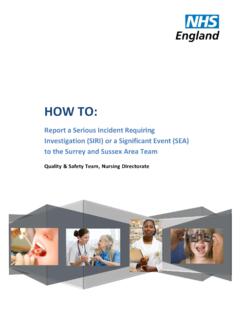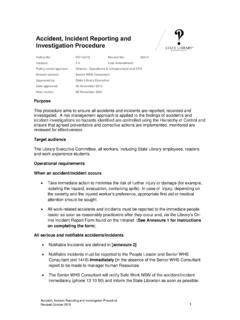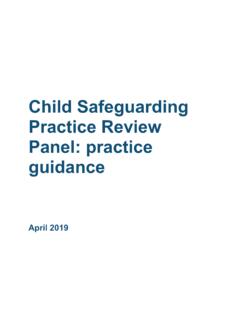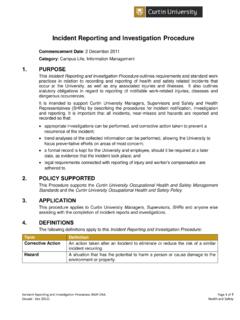Transcription of Patient Safety Incident Response Framework 2020
1 NHS England and NHS Improvement Patient Safety Incident Response Framework 2020 An introductory Framework for implementation by nationally appointed early adopters March 2020 1 | Contents Contents Foreword .. 5 Summary .. 7 Key differences between the PSIRF and the serious Incident Framework (2015) .. 10 Introduction .. 13 Purpose and scope .. 13 Why judgements about culpability do not fit with PSIIs conducted for the purposes of learning in the NHS .. 14 Alignment with existing duties and regulations .. 15 Implementation of the Framework .. 15 Part A: Preparing to respond to Patient Safety incidents .. 16 Step 1: Establish the behaviours of an effective and compassionate Patient Safety reporting, learning and improvement system.
2 16 Openness and transparency .. 16 A just culture .. 18 Continuous learning and improvement .. 20 Step 2: Develop a Patient Safety Incident Response plan .. 23 Responding to incidents .. 24 Planning which incidents will require PSII .. 26 Case study .. 29 Supporting cross-system Patient Safety Incident investigation .. 30 Independent Patient Safety Incident investigations and public inquiries .. 31 Interface with other types of review and/or investigation .. 32 National standards for local systems-based Patient Safety Incident investigation in NHS-funded care .. 32 Timescales for Patient Safety Incident investigations .. 34 Patient Safety partners .. 34 Step 3: Design systems to support the needs of those affected.
3 34 Patients, families and carers .. 35 Staff .. 36 Step 4: Prepare, test and review the Patient Safety Incident Response system to identify and address weaknesses .. 37 Questions leaders should ask to support review .. 38 2 | Contents Example scenario .. 39 Testing systems in commissioning and oversight bodies .. 40 Example .. 40 Part B: Responding to Patient Safety incidents .. 42 Step 1: Identify those affected, take immediate remedial action and establish ongoing support .. 42 Step 2: Notify others, record information and secure evidence .. 43 Step 3: Examine incidents appropriately (based on the local PSIRP) .. 45 Step 4: Share Safety insight, implement improvements/ solutions to prevent harm and monitor impact.
4 45 Share Safety insight .. 47 Implementing improvements/solutions to prevent harm and monitor impact .. 47 Part C: Governance arrangements .. 49 Patient Safety Incident data .. 49 Providers of NHS-funded care .. 52 Medical examiner system .. 56 Commissioning organisations .. 57 New commissioning models .. 57 NHS England and NHS Improvement regional teams (system oversight) .. 60 Specialised commissioning .. 61 Care Quality Commission .. 61 Healthcare Safety Investigation Branch .. 62 Coroners .. 62 Appendix 1: Supporting patients, families and carers .. 64 Principles of the being open Framework .. 64 1. Acknowledgement .. 64 2. Truthfulness, timeliness and clarity of communication .. 64 3. Apology.
5 65 4. Recognising Patient and carer 65 5. Professional support .. 65 6. Risk management and systems improvement .. 66 7. Multidisciplinary responsibility .. 66 8. Clinical governance .. 66 9. Confidentiality .. 67 10. Continuity of care .. 67 Sources of support .. 67 3 | Contents Appendix 2: Roles and responsibilities .. 69 Trust boards (including board quality sub committees) .. 69 Chief executive .. 69 Governors (where applicable) .. 70 Executive lead for supporting and overseeing implementation of the 70 Patient Safety team/committee (or relevant alternative) .. 71 Patient Safety Incident investigators .. 72 Named contacts for patients, families and carers .. 72 Named contacts for staff.
6 73 Department leads/managers .. 74 All staff .. 74 Commissioners and commissioning organisations (including CCGs, NHS England and NHS Improvement, STPs, ICSs/ICPs) .. 74 Appendix 3: Support for staff following a Patient Safety Incident .. 78 Mental Health First Aid (MHFA) England .. 78 Caring for the caregivers .. 78 Being open .. 78 Freedom to Speak Up .. 78 A just culture guide .. 79 The ASSIST ME model .. 79 Local occupational health services .. 79 A-EQUIP midwifery supervision model .. 79 Appendix 4: Maternity Incident investigations .. 81 Patient Safety incidents requiring referral to HSIB for investigation .. 81 Criteria for HSIB investigations .. 81 Reporting Patient Safety incidents meeting the Each Baby Counts and maternal deaths criteria.
7 82 Reporting to HSIB .. 82 Reporting to the National Reporting and Learning System (NRLS) and Strategic Executive Information System (StEIS) .. 82 Responsibilities for incidents referred to HSIB under Duty of Candour .. 82 Maternity incidents requiring a local Response .. 83 Appendix 5: Co-ordinating Response to incidents spanning service, organisational and agency boundaries .. 85 4 | Contents Appendix 6: Incident types and associated guidance for required specific processes .. 88 5 | Foreword Foreword The NHS has systems to support the reporting of Safety incidents and from these reports it learns how to make healthcare safer. However, despite these efforts and the continuing advances in Patient care, the inherent risks and complexity of healthcare mean an NHS entirely free of incidents is an unrealistic expectation.
8 Identifying incidents, recognising the needs of those affected, examining what happened to understand the causes and responding with action to mitigate risks remain essential to improving the Safety of Creating systems that do this is a complex, challenging and continuous endeavour that requires the right skills, processes and perhaps most importantly behaviours. We know that organisations are struggling to deliver good quality investigations that consistently support the reduction of risk. As a result, opportunities to reduce Patient Safety incidents can be Bright spots 3 in the NHS and insight from other industries demonstrate that the challenges are not insurmountable and addressing them results in action that achieves measurable change and improvement; avoids further unintended harm; and maintains Patient and public trust and confidence in the NHS.
9 This introductory Patient Safety Incident Response Framework responds to calls for a new approach to Incident management, one which facilitates inquisitive examination of a wider range of Patient Safety incidents in the spirit of reflection and learning rather than as part of a Framework of accountability .4 Informed by feedback and drawing on good practice from healthcare and other sectors, it supports a systematic, compassionate and proficient Response to Patient Safety incidents; anchored in the principles of openness, fair accountability, learning and continuous improvement. 1 Conway J, Federico F, Stewart K, Campbell MJ (2011) Respectful management of serious clinical adverse events, second edition.
10 IHI Innovation Series white paper. Cambridge, MA: Institute for Healthcare Improvement. Available at 2 See details of our engagement programme, The future of Patient Safety investigation. 3 Dixon-Woods M, Baker R, Charles K, et al (2014) Culture and behaviour in the English National Health Service: overview of lessons from a large multimethod study. BMJ Qual Saf 23: 106 15. 4 Vincent C, Amalberti R (2016) Safer healthcare strategies for the real world. Springer. 6 | Foreword Its release marks the start of transforming the way the NHS responds to things going wrong. Our approach refocuses systems, processes and behaviours on delivering a sustained reduction in risk, rather than simply applying a reactive, bureaucratic process that too often does not lead to change.














